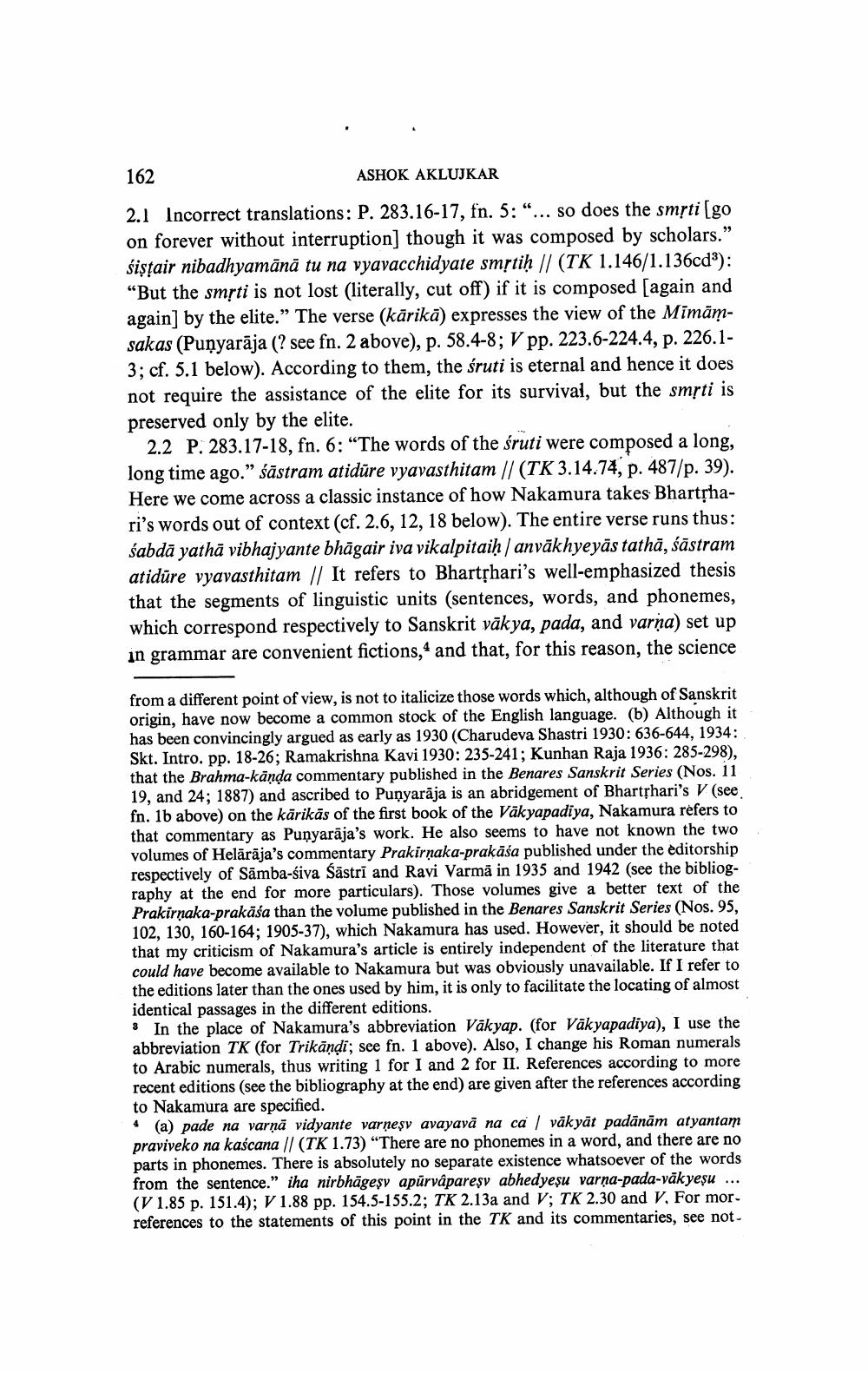Book Title: Nakamura On Bhartrhari Author(s): Ashok Aklujkar Publisher: Ashok Aklujkar View full book textPage 2
________________ 162 ASHOK AKLUJKAR 2.1 Incorrect translations: P. 283.16-17, fn. 5: “... so does the smrti[go on forever without interruption] though it was composed by scholars." śişțair nibadhyamānā tu na vyavacchidyate smstiḥ // (TK 1.146/1.136cd): “But the smrti is not lost (literally, cut off) if it is composed [again and again) by the elite." The verse (kärikā) expresses the view of the Mimāmsakas (Puṇyarāja (? see fn. 2 above), p. 58.4-8; V pp. 223.6-224.4, p. 226.13; cf. 5.1 below). According to them, the śruti is eternal and hence it does not require the assistance of the elite for its survival, but the smrti is preserved only by the elite. 2.2 P. 283.17-18, fn. 6: “The words of the śruti were composed a long, long time ago." śāstram atidūre vyavasthitam // (TK 3.14.74, p. 487/p. 39). Here we come across a classic instance of how Nakamura takes Bhartshari's words out of context (cf. 2.6, 12, 18 below). The entire verse runs thus: śabdā yathā vibhajyante bhāgair iva vikalpitaiḥ, anvākhyeyās tathā, śāstram atidūre vyavasthitam // It refers to Bhartshari's well-emphasized thesis that the segments of linguistic units (sentences, words, and phonemes, which correspond respectively to Sanskrit vākya, pada, and varņa) set up in grammar are convenient fictions, and that, for this reason, the science from a different point of view, is not to italicize those words which, although of Sanskrit origin, have now become a common stock of the English language. (b) Although it has been convincingly argued as early as 1930 (Charudeva Shastri 1930: 636-644, 1934: Skt. Intro. pp. 18-26; Ramakrishna Kavi 1930: 235-241; Kunhan Raja 1936: 285-298), that the Brahma-kānda commentary published in the Benares Sanskrit Series (Nos. 11 19, and 24; 1887) and ascribed to Punyarāja is an abridgement of Bharthari's V (see fn. 1b above) on the kārikās of the first book of the Vakyapadiya, Nakamura refers to that commentary as Punyarāja's work. He also seems to have not known the two volumes of Helārāja's commentary Prakirņaka-prakāśa published under the editorship respectively of Samba-śiva Šāstri and Ravi Varma in 1935 and 1942 (see the bibliography at the end for more particulars). Those volumes give a better text of the Prakirnaka-prakāśa than the volume published in the Benares Sanskrit Series (Nos. 95, 102, 130, 160-164; 1905-37), which Nakamura has used. However, it should be noted that my criticism of Nakamura's article is entirely independent of the literature that could have become available to Nakamura but was obviously unavailable. If I refer to the editions later than the ones used by him, it is only to facilitate the locating of almost identical passages in the different editions. 3 In the place of Nakamura's abbreviation Väkyap. (for Vākyapadiya), I use the abbreviation TK (for Trikāndi, see fn. 1 above). Also, I change his Roman numerals to Arabic numerals, thus writing 1 for I and 2 for II. References according to more recent editions (see the bibliography at the end) are given after the references according to Nakamura are specified. 4 (a) pade na varnā vidyante varneșy avayavă na ca / vāk yāt padānām atyantam praviveko na kaścana // (TK 1.73) “There are no phonemes in a word, and there are no parts in phonemes. There is absolutely no separate existence whatsoever of the words from the sentence.” iha nirbhāgeșy apūrvâpareșy abhedyeșu varņa-pada-vāk yeșu ... (V 1.85 p. 151.4); V 1.88 pp. 154.5-155.2; TK 2.13a and V; TK 2.30 and V. For morreferences to the statements of this point in the TK and its commentaries, see not.Page Navigation
1 2 3 4 5 6 7 8 9 10 11 12 13 14 15
